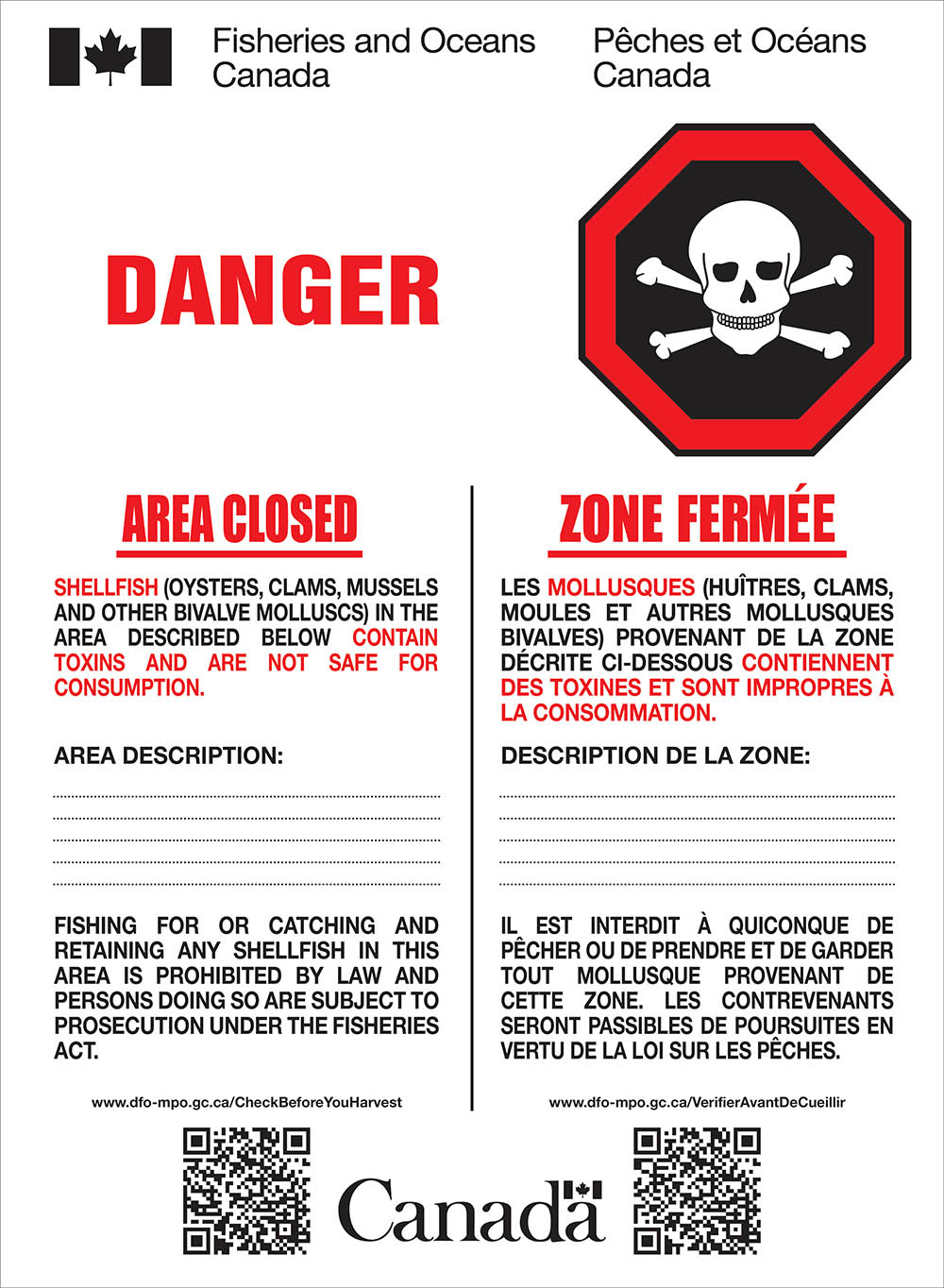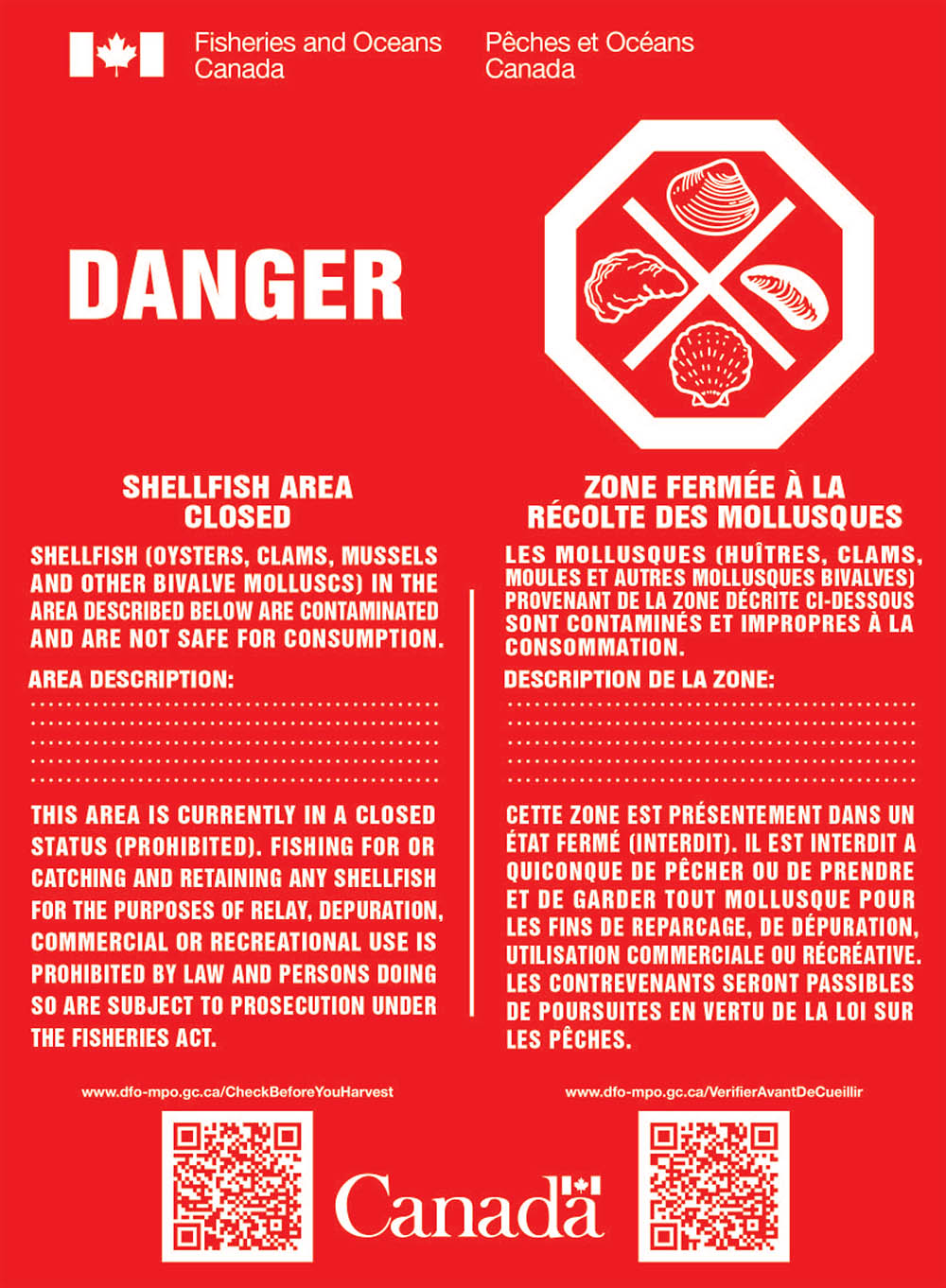What do I need to know before harvesting shellfish?
The information below applies to recreationally harvesting shellfish in the Maritimes Region for your own consumption. This region extends from the northern tip of Cape Breton to the New Brunswick-Maine border.
Note
Those who wish to harvest shellfish commercially must obtain a permit. For more information on commercial fishing licenses, call toll-free 1-877-535-7307.
Frequently asked questions
Question 1: What is the maximum daily limit for clams?
The maximum daily limit varies by clam harvesting area. The limit is 100 clams in CHA 1, the portion of CHA 2 in the Annapolis Basin, and CHA 7; the limit is 150 clams in Shelburne County; the limit is 200 clams in CHA 2 outside of the Annapolis Basin, and in CHA 3; the limit is 300 clams in CHA 3, the portion of CHA 4 outside Shelburne County, and CHA 5. That means no more than this maximum number of clams, of all species combined from any or all of the following species can be caught and retained in any day: bar clam, bay quahaug, razor clam and soft-shell clam.
Question 2: How do I find out where I can go to harvest shellfish? Are there places I cannot go?
It is your responsibility to find out if an area is closed to shellfish harvesting.
Harvesting shellfish from closed or prohibited areas is illegal. Closed areas are marked by coloured signs installed by Fisheries and Oceans Canada.
To find out which areas are closed, please visit the Orders Registry page for the Maritimes Region, select “Prohibition” under order type and search by keyword the area of interest, for example, Dartmouth or St. Andrews. You can also consult the real-time map of openings and closures.
For more information or to get clarification on which areas are closed, you can call one of the Conservation and Protection detachment offices listed in the following link and speak to a fishery officer.
Harvesting of shellfish is prohibited at all times within 125 metres (410 feet) of a wharf, and aquaculture operation, for example, aquaculture-growing cages.
Question 3: What do the coloured signs indicate?
Coloured signs posted in a shellfish harvesting area indicate the zone is closed and that the recreational harvesting of shellfish is not allowed. The colour of the signs indicates the reason for the closure.
White sign
White signs indicate an area is closed due to toxins and shellfish is not safe to eat.

Danger: Area Closed
Shellfish (oysters, clams, mussels and other bivalve molluscs) in the area described below contain toxins and are not safe for consumption.
Area description:
Fishing for or catching and retaining any shellfish in this area is prohibited by law and persons doing so are subject to prosecution under the Fisheries Act.
Red sign
Red signs indicate an area is closed and shellfish are contaminated and not safe to eat.

Danger: Shellfish Area Closed
Shellfish (oysters, clams, mussels and other bivalve molluscs) in the area described below are contaminated and are not safe for consumption.
Area description:
This area is currently in a closed status (prohibited). Fishing for or catching and retaining any shellfish for the purposes of relay, depuration, commercial or recreational use is prohibited by law and persons doing so are subject to prosecution under the Fisheries Act.
Yellow sign
Yellow signs indicate an area is closed and shellfish are contaminated and not safe to eat.

Danger: Shellfish Area Closed
Shellfish (oysters, clams, mussels and other bivalve molluscs) in the area described below are contaminated and are not safe for consumption.
Area description:
This area is closed. Unless authorized by a licence issued under the management of contaminated fishery regulations, fishing for or catching and retaining any shellfish in this area is prohibited by law and persons doing so are subject to prosecution under the Fisheries Act.
Question 4: What shellfish can I harvest recreationally in each province of the Maritimes Region?
New Brunswick (coast bordering the Bay of Fundy)
Soft-shell clam, bar clam, bay quahaug, mussel, Atlantic razor clam (razor clam), scallop
Nova Scotia (Scotia-Fundy coast, from Cape North to the Bay of Fundy)
Soft-shell clam, bar clam, bay quahaug, mussel, razor clam, scallop, oyster
Question 5: Do I need a licence to harvest shellfish recreationally?
A licence is not required for soft-shell clams, bar clams, bay quahaugs, mussels or razor clams.
Oysters
A licence is required for this fishery open to residents of Nova Scotia only. Please note, new for 2019, the daily catch and retention limit of 150 oysters is also the possession limit. Licence holders may not possess more than 150 oysters at any one time. The recreational fishery for oysters is closed in New Brunswick.
Scallops
A licence is required for this fishery in the Maritime Provinces.
To obtain a licence, a request has to be made using the National Online Licensing System. If you require assistance, please contact the Client Support by email at fishing-peche@dfo-mpo.gc.ca or toll free at 1-877-535-7307.
Question 6: What equipment or tools am I allowed to use?
Clam species (soft-shell clam, bar clam, bay quahaug, razor clam)
In the two provinces of the Maritimes Region, hand or hand-held tools (rakes or shovels) may be used for these species when not diving.
Mussels
These shellfish are hand-picked and hand-held tools such as rakes or shovels may be used.
Oysters
They must be harvested using tongs or rakes.
Scallops
Scallops must be harvested recreationally by diving underwater.
Question 7: Why is it important to follow regulations and closures related to shellfish harvesting?
Recreational harvesters must comply with regulations and orders related to shellfish harvesting, such as area closures, daily catch limits, minimum size limits and seasons. Offenders will be prosecuted. Shellfish harvesting areas are closed to protect harvesters and the public.
As shellfish feed by filtering microscopic organisms from the water, harmful bacteria, viruses and biotoxins can build up in their tissues and may cause illness in people who consume affected shellfish. The Canadian Food Inspection Agency, Environment and Climate Change Canada and Fisheries and Oceans Canada work together to regularly test shellfish areas and to close them when risks are identified.
Eating contaminated shellfish can cause potentially serious or fatal illness. Cooking shellfish does not destroy many of the toxins that may be present in a closed area.
Information on the health risks associated with illegal harvesting can be found here.
Areas which are closed to shellfish harvesting are identified by coloured signs posted by fishery officers with the Department of Fisheries and Oceans.
Enjoy safe shellfish - check before you harvest
- Date modified: